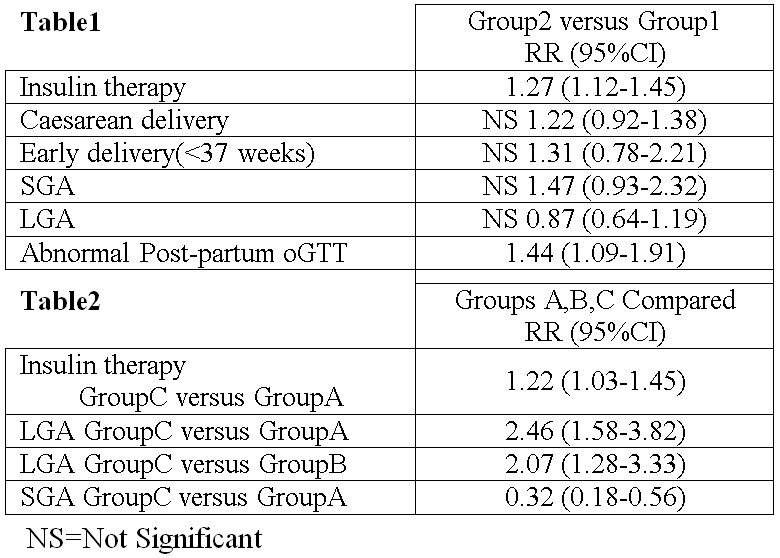Oral Presentation Australian Diabetes Society and the Australian Diabetes Educators Association Annual Scientific Meeting 2014
Gestational Weight Gain in Obese Women with Gestational Diabetes: Maternal and Baby Outcomes in a Multi-ethnic Cohort in South Western Sydney (#146)
Background: We previously reported pregnancy outcomes in obese women with gestational diabetes(GDM)(1).
Aim: To assess maternal and baby outcomes and effect of gestational weight gain(GWG) in a multi-ethnic cohort of women with obesity and GDM in South Western Sydney.
Methods: Retrospective analysis of prospectively collected data, (1993-2013), on women diagnosed by ADIPS(1998) criteria(2). We assessed those with complete data including: ethnicity, pre-pregnancy BMI (based on self-reported weight), and last clinic weight recorded <4 weeks pre-delivery. We compared women with BMI 30-34.9kg/m2(Group1) to those with BMI≥35kg/m2(Group2). We also assessed total pregnancy weight gain divided by weeks to last recorded weight in three GWG groups: GroupA <0.18 kg/week; GroupB 0.18-0.27 kg/week; GroupC >0.27 kg/week based on Institute Of Medicine(IOM) recommendations(3). Selected women had delivery outcome data and the majority had a post-partum oGTT. We assessed six outcomes: insulin use, caesarean delivery, early delivery(<37 weeks), large and small for gestational age birthweight(LGA, SGA), plus 6-8 week post-partum glucose tolerance test(oGTT) data (where available). Birthweights were categorized SGA(<10th percentile) and LGA(>90th percentile) using the website www.gestation.net(4). We calculated Relative Risk(RR) and 95% confidence intervals(95%CI).
Results: There were 740 women [with oGTT data for 393(53.1%), (mean±SD) 9.7±2.6 weeks post-partum]: Group1 n=434; Group2 n=306; and 94.5% had GWG data: GroupA n=201; GroupB n=137; GroupC n=361. Table1 and Table2 show significant differences for Group2 versus Group1 and for GWG Groups. The findings were: Group2 was more likely to have insulin therapy and an abnormal post-partum oGTT. For GWG, there were no significant differences for GroupB versus GroupA, but there was more insulin therapy, greater risk of LGA births and less risk of SGA births amongst those gaining more weight than recommended (GroupC) compared to less weight than recommended (GroupA).

Conclusions: In this cohort, the findings highlight the importance of weight management in obese women with GDM.
Acknowledgments: All the Diabetes Educators who collected data and maintained the database and Professor Jason Gardosi for permission to use his bulk centile calculator.
- Impact of obesity on pregnancy outcomes in women with gestational diabetes mellitus. Jeff R Flack, Glynis P Ross, Robyn A Barnes. Abstract 106, Proceedings Australasian Diabetes In Pregnancy Society Meeting Sydney Aug 2013.
- Hoffman L, Nolan C, Wilson JD, Oats JJN, Simmons D. Gestational diabetes mellitus – management guidelines. The Australasian Diabetes in Pregnancy Society. Med J Aust 1998; 169:93–97.
- Institute of Medicine and National Research Council. Weight Gain During Pregnancy: Reexamining the Guidelines. Washington DC: The National Academies Press, 2009.
- Gardosi J, Francis A. Customised Weight Centile Calculator – GROW-Centile v5.15/6.4 2009. Gestation Network, www.gestation.net (v5.15: individual; v6.4: bulk centiles).